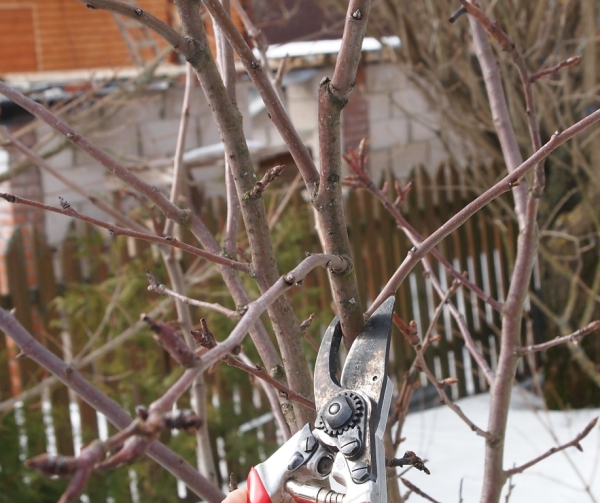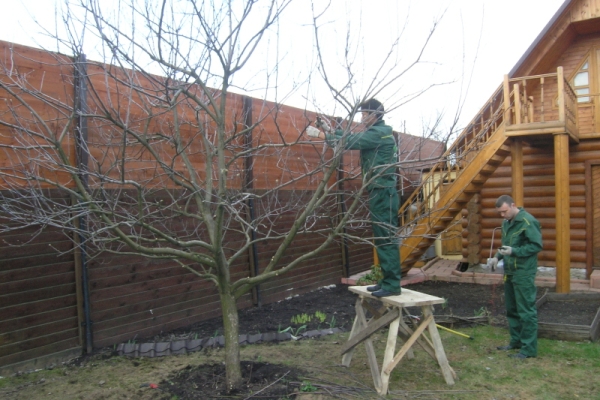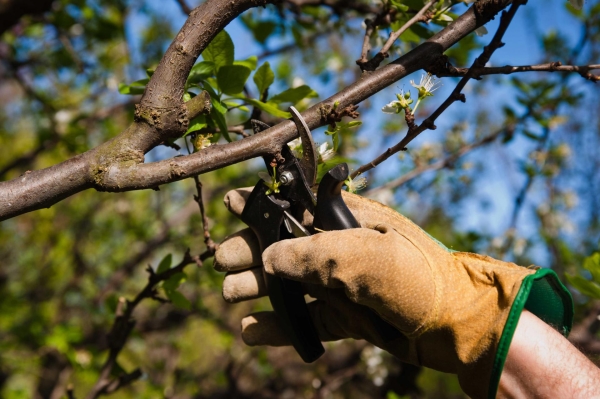Fruits of sweet cherry are tasty and useful. However, not everyone can get a good harvest: the plant is quite demanding in its care. One of the mandatory activities is pruning.
Table of contents
Dates and appointment
Cherry is pruned literally from the first year of growth of a sapling in a permanent place.And do it both in the spring, in the summer and in the fall. Each manipulation implements certain tasks.
Why prune in spring?
Conducted in several stages:
- in the beginning of March, immediately after the snow melts, sanitary pruning is carried out, removing branches damaged during the winter;
- in April, before the active movement of tree sap and bud swelling, begin forming pruning, designed to correct, and in the case of young trees, start the formation of the crown of the tree.

Do you need crown formation in summer?
About the need for a summer pruning gardeners are ambiguous.
Stages of summer pruning cherries:
- in late May, early June, after flowering, but before the start of ripening of the fruits, in order to stimulate the growth of horizontal branches and correct the direction of their growth, they are pruned using the pinching method (pinching) of still non-lumbering shoots. At the same time, the main trunk is shortened;
- in the middle of July and until the beginning of August, after harvesting, shoots grown after the first pruning are shortened by 10 cm.
Proper pruning in the fall
Is held after the fall of the foliage with the aim of:
- thinning: removal of broken, old and weak, as well as branches and branches growing at the wrong angle;
- shortening the length of the shoots by a third.
Autumn processing needs to be completed in September. In the fall, the wounds from the slices are slowed down. The tree must recover before the arrival of the cold.
Sweet cherry pruning:
Rules of conducting
Formative pruning required in the first year after planting. It will allow to form a compact, regular shape and good density of the crown.
The growth of young shoots at an acute angle with respect to the fruit-bearing branch is adjusted with the help of a load or a garter to a branch growing below. This eliminates the risk of breaking the fertile branch.
Once in 5 years rejuvenating pruning is carried out.
These simple rules will allow you to avoid mistakes, grow sweet cherries with the correct crown and get excellent harvest.
Types of pruning
Formative: from first to sixth year
Carried out in order to form a correct crown, consisting of 2 or 3 tiers.
Shaped pruning held in the spring during the first 6 years after planting sweet cherries
Works in the first, after landing, spring:
- on the seedlings note the height of the trunk. It usually ranges from 30 to 60 cm;
- put the mark, counting up to escape a maximum of 6 buds;
- make a cut.
Next spring:
- We select 3-4 young shoots growing in the lower part of the crown on opposite sides of the main trunk. They will form the basis of the first tier. We carry out pruning of these branches, leaving half a meter of length;
- among the shoots of the lower tier, choose the one that grows above the rest. We measure it by length 70 cm along its length, then we count 4-6 buds and make a cut.
On the third spring We continue the forming trim from the lower tier:
- we cut the upper branches to the level of the lower knot;
- we delete the branches growing at an acute angle or inside the crown.
It is important not to touch the bottom, often poorly developed, branch.
Processing branches of the second tier:
- we select strong, less than 30 cm long, shoots. We carry out their pruning.The length of the branches of the second tier should be 10-15 cm less than the length of the branches of the first tier;
- among the shoots of the second tier we distinguish growing above the rest. We measure about half a meter along its trunk and, having counted 4-6 buds, we make a cut;
- adjust the length of the remaining branches of the second tier: it should be 20 cm shorter than the central trunk.

Formation of the crown in the spring of the fourth year:
- choose and shorten one of the weak side shoots to half a meter;
- trim the center conductor, making the cut above the shortened shoot.
If there are branches on the cherry tree, located above the second tier, we will form 3:
- cut branches to a length shorter than the main stem by 20 cm;
- we remove short branches together with the central conductor, making the cut below the discharge of the thinnest shoot.
We complete the work by adjusting the length of branches 1 and 2 tiers:
- we shorten the outward and long (over 80 cm) shoots of the first and second orders by a length not exceeding 75 cm;
- cut the shoots growing inside the crown.
Spring of the fifth and sixth year We continue to work on the formation of the crown according to a scheme similar to the previous one:
- shorten shoots longer than half a meter;
- we get rid of the branches intertwining and directed inside the crown;
- among short, up to 50 cm, shoots, remove all growing at an acute angle;
- along the central trunk we cut off all large shoots of lengthening, thereby transferring them to short lateral branches.
During the fruiting of the tree
Hygienic or sanitary
Plants, like people, are characterized by aging. His signs are:
- reducing the number of fruits and sizes of berries;
- the deterioration of the taste of berries;
- frequent plant diseases.
All these manifestations of aging say about the need for anti-aging pruning.
It consists in a significant, up to the length of a two-year plant, the shortening of all branches and is carried out after fruiting.
Radical sweet pruning - why and why:
In order to limit growth
What to do, if for some reason, the sweet cherry is stretched upwardstaking the fruit beyond their reach by man?
The adjustment of the crown begin with the removal of all strongly raised and growing branches directly at the crown. This activates the development of external branches.
Growing branches will be located at a large angle of separation from the skeletal shoots and weaker than the previous ones. But this is exactly what we need.
After removing growing up branches the crown will become lighter, wider and lower. As soon as the sweet cherry recovers from the cuts, its growth will begin. At the site of the remote shoots will remain only minor bends.
Important in the future prevent general thickening of the crown, while tracking the growth of shoots directed inside the crown.

Supportive
After forming a trim on the tree replacement shoots will appear. It's unavoidable. They are subject to unconditional removal.
The sooner you notice such a shoot, the easier it will be to remove and the more sweet the cherries will transfer this procedure.
You will be interested in these publications:
Lateral branches will also increasethat are removed after fruiting. They are cut from bottom to top in descending order, forming longlines and giving the crown a pyramidal shape.
Otherwise, the upper shoots will darken the lower ones, leading to their weakening.
Errors
| Appearance of pruning errors | The reasons |
| Instead of the expected intensified development of the outer branches, there was an intense increase in tops. | Growth translation is transferred to a too weak side branch. |
| The appearance of a large number of tops, leading to crown thickening, late fruiting and displacement of fruits to the periphery of the crown. | Excessive shortening of shoots during pruning. |
| The dying off of weakened lower branches, leading to the exposure of the trunk and the placement of fruits on the upper tier. | When forming the tiers, the branches of the lower tier were weaker than the upper ones. |
Nuances of trimming:
- Trimming the trunk and escape of any age, do not make too low cuts, but do not leave hemp.
- Sawing 3-5-year-old branches, gradually loosen the pressure of the hacksaw by the time the process is completed. This will reduce the risk of bark tearing.
- Removing the lower massive branches, make deep-nib files from the underside of the shoot.This will protect the branches from falling, if you do not keep them, while maintaining the integrity of the bark.
Cherry trimming scheme with step by step explanations
Step 1. Formation of the skeleton of the crown and planning its height.
Is the main stage of the formation of the crown by lowering its height. Work is convenient to hold in the spring, before the foliage:
- Selection of skeletal branches of the lower (first) tier: carefully consider the tree, beating it from all sides. Visually determine the choice of the main (skeletal) branches.
- Trimming the side branches of the lower tier: select 3-4 lower branches that grow horizontally in different directions from the trunk. Annual side trimming of these branches, you can achieve the expansion of the crown.
- The formation of the basis of the following tiers is carried out in a similar way.
- Plan the desired tree height and make a mark on the main trunk.

Step 2. Gradual removal of the main trunk.
It is an addition to the first and carried out directly after it:
- We make a cut above the mark placed on the main trunk (Step 1, point 4) and the third tier.It should go about ½ of the length of the segment to the horizontal branch of 3 tiers left by us (Step 1, point 3).
- We are waiting for the emergence of new shoots leaders. We grow them by 20-30 cm. As soon as this happens (approximately in July), the tree is ready for the final procedure.
Step 3. Removal of the main trunk.
We complete the gradual shortening of the leader, making a cut along the previously made mark (Step 1, item 4).
The process of pruning strong-growing cherries:
Phased trimming tactics reduce the likelihood of a large number of tops, and those that appear will be weak. The tree that is saved will be used for development and fruiting.
As you see Sweet cherry pruning is not a very complicated procedure.. Having studied the relevant literature and having understood the schemes, the novice will cope with it.
It remains to recall that the main condition for the effective conduct of pruning is regularity. According to experienced gardeners, if a tree regularly shows what you want from it, it will understand you and will not run up.
